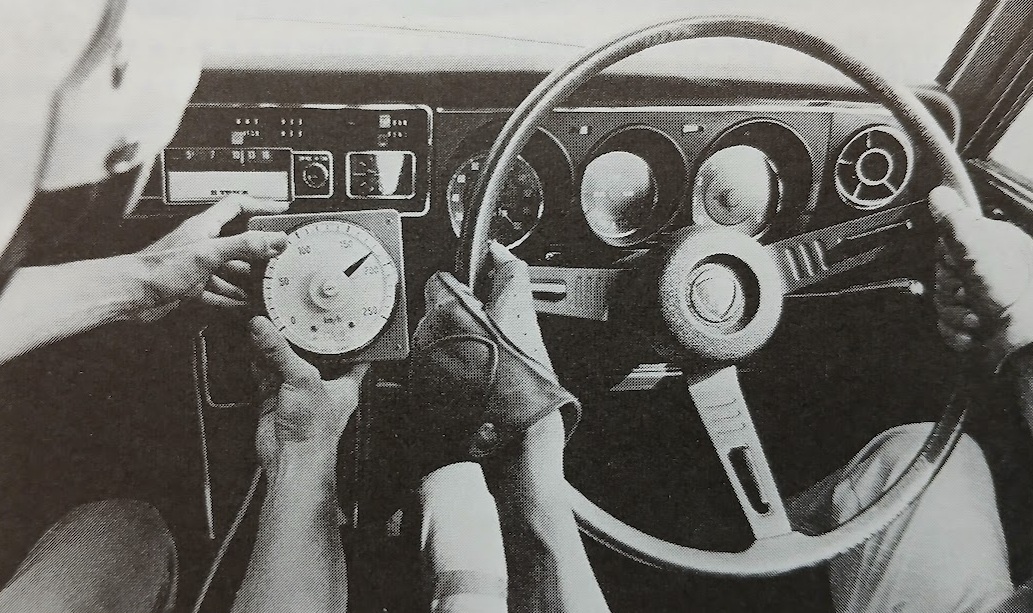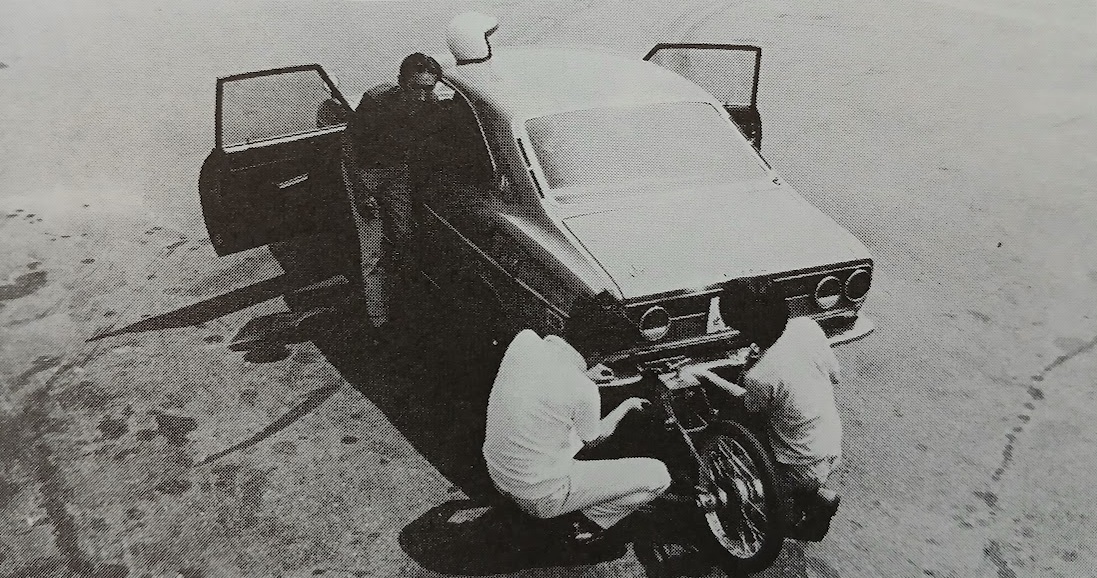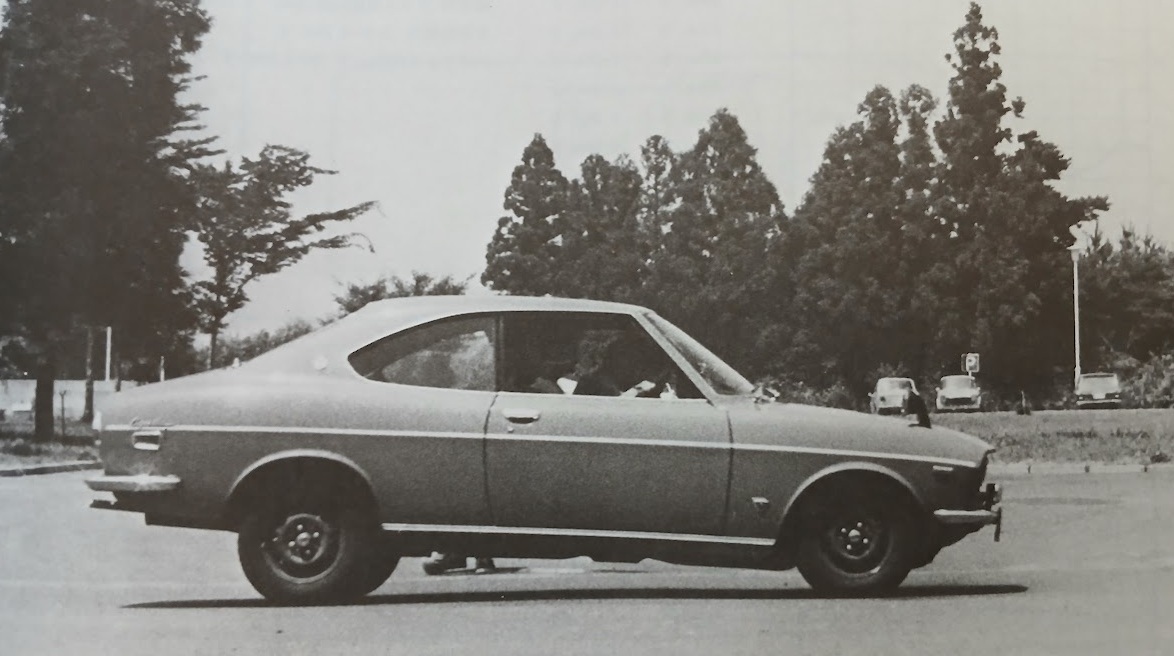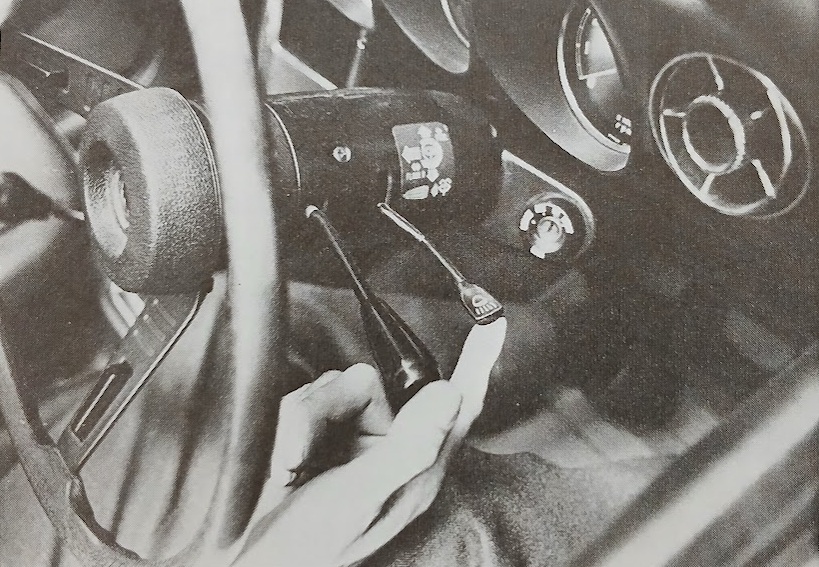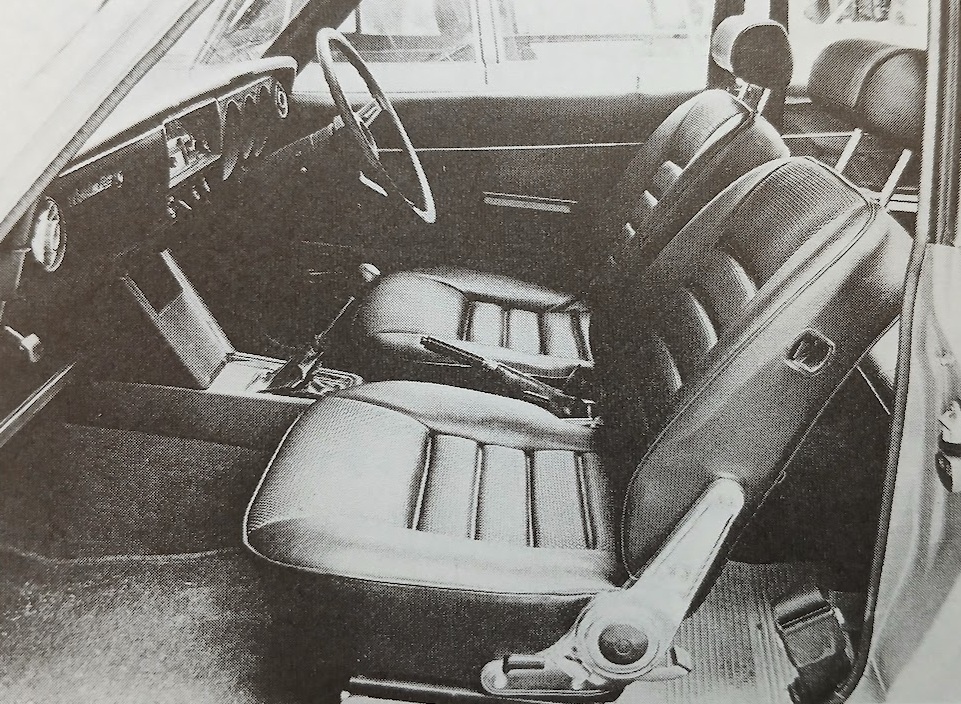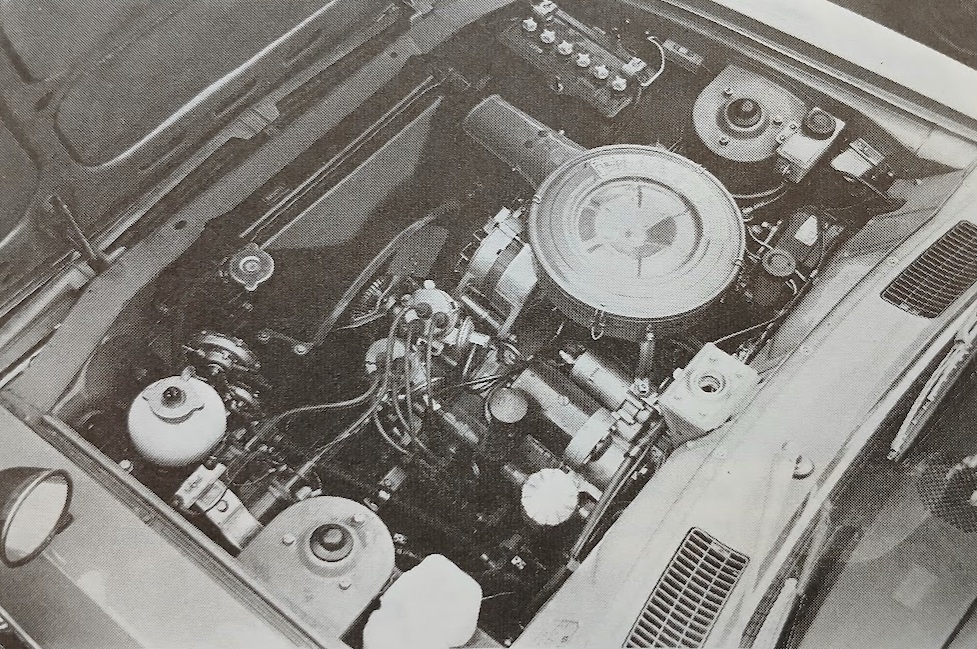Mazda Capella Rotary Coupe GS (1970)
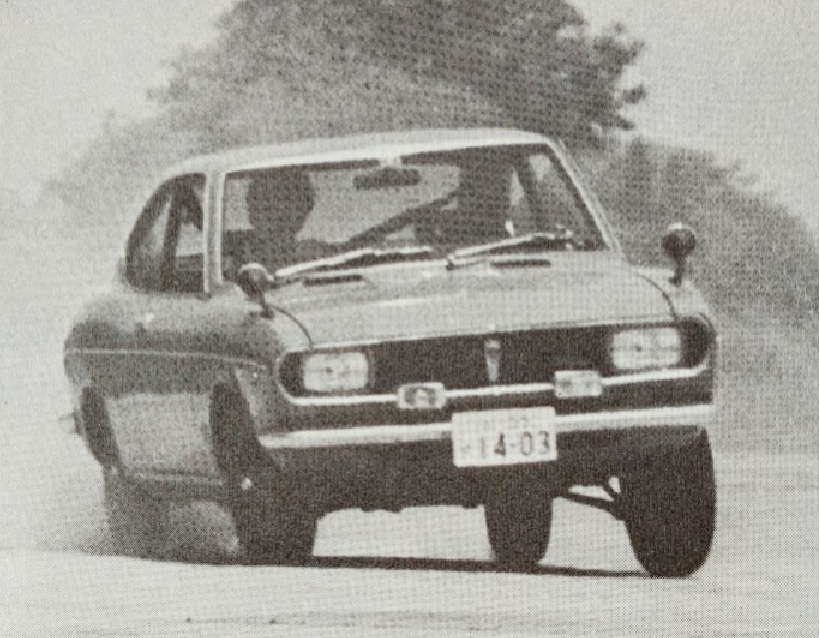
Publication: Car Graphic
Format: Road Test
Date: October 1970
Author: “C/G Test Group” (uncredited)
Summary: Exceptionally smooth and powerful rotary engine, conversation possible while cruising at 160km/h, strong mid-range torque makes it easy to drive in urban areas, maneuverability and ride comfort both at a high level. Lots of nose dive during hard braking, early rear wheel lock, effective ventilation.
Road testing the Capella Rotary Coupe GS
C/G took notice of the future potential of rotary piston engines early on, and we purchased a Familia Rotary Coupe as soon as it was released, in July 1968.
Since then, we have been conducting a long-term test of the car for about 47,000km, over the course of two years, and have been publishing reports from time to time. During our time with the car, the only serious engine trouble was when the oil seal (corresponding to the oil scraper ring of a reciprocating engine) of the No. 2 rotor wore out at about 35,000km, which caused excessive oil consumption (250km/liter), and this seal had to be replaced. After that, the oil consumption recovered to about 1,000km/liter, and the car still had plenty of working life left, but the time for the vehicle inspection was approaching. While we were wondering what we should do, the Capella was released onto the market, so we decided to purchase the latest in Mazda’s “rotaryization” once again.
The C/G Capella is a Coupe GS, the highest-performance model (and also the most expensive, at 845,000 yen) in the series. Our preference for the paint color was deep green, but this was not among the first batch that arrived at the dealership (C/G’s color preferences rarely match the manufacturer’s demand forecast, which means that our tastes do not seem to be in line with those of the general public), and the Capella that was delivered to the C/G office on the evening of July 22nd was a trendy bright orange.
Without a doubt, the most interesting thing about this car is its rotary engine, so let’s start by outlining its design. The 12A type rotary engine is slightly larger than the 10A type used in the Familia Rotary and Cosmo, with a single chamber volume of 573cc (compared to the 10A’s 491cc). This was achieved by increasing the width of the rotor housing by 10mm, so that the trochoid radius is the same, and so it can be manufactured using the same machine tooling as the Familia (or Cosmo). The Capella’s 12A rotary generates an output of 120ps/6500rpm and a maximum torque of 16.0kgm3500rpm, while the 10A generates 100ps/7000rpm and 13.5kgm/3500rpm in the Familia, or 128ps/7000rpm and 14.2kgm/5500rpm in the Cosmo.
There were only three days between delivery of the car and the scheduled test at Yatabe, during which time we had to complete the running-in period (according to the handbook, 1,000km is sufficient, which is much shorter than a reciprocating engine) and have the car undergo its first service. The staff took turns running the car in day and night, but by the time we brought the car to Yatabe, it had still only done about 1,700km. We were a little apprehensive about conducting a rigorous top speed test on this essentially new car (especially considering that we would be using it as our own car for a long time to come), but in the end we were able to record excellent power performance almost matching the catalog values.
First, let’s look at the numbers. The C/G top speed test is a tough one, with the car running continuously flat-out on the Yatabe course, measuring the average speed on the 1km straight section and the 5.5km circuit (the top speeds announced by manufacturers are either instantaneous figures achieved for only a few moments, or figures calculated on paper). The Capella recorded a consistent average speed of 187.5km/h over the 1km straight section, and 186.6km/h over the 5.5km circuit. It is literally the fastest domestic practical car that C/G has ever tested, and even if we include GT cars, the only domestic car faster than the Capella is the old Fairlady 2000, which sacrificed everything else for performance.
Looking back at our past tests, the top speed data we obtained for the Skyline 2000GT-R (179.6km/h) and Z432 (175.6km/h) were particularly poor results, far below the cars’ true potential. In the GT-R’s case, this was due to the test car experiencing clutch slip during testing, but it is also evidence of the extreme difficulty in keeping a twin-cam, triple-carburetor, four-valve semi-racing engine in a perfect state of tune. In contrast, the stock Capella and Familia Coupe (both C/G long-term test cars) were brought to Yatabe without any special attention, and achieved speeds close to the catalog values (190km/h and 180km/h, respectively). This demonstrates one aspect of the superiority of the rotary engine, with its simple structure, over reciprocating engines. Internationally, the only 2000cc class practical cars that were this fast in our tests were the Alfa Romeo 1750GTV and the BMW 2002, and only the Porsche 911 significantly surpassed the Capella (the 911 is essentially a two-seater and, needless to say, costs several times more).
The Capella’s rev counter has a yellow zone from 6500 to 7000rpm and a red zone from 7000 to 8000rpm. The overall gear ratios are slightly over-geared for the power and weight of the car. In other words, the top speed of 187.5km/h at Yatabe (the car’s speedometer was completely over-scaled and showed 215km/h at this speed) was equivalent to about 6750rpm, still within the yellow zone. A few weeks after the Yatabe test, when the odometer had reached 4,300km, we tried to match this speed on the FISCO circuit, but at the end of the straight on the right-hand course, we ran out of space and had to ease off the throttle halfway around the banking.
We’ve mentioned many times how the rotary engine revs up nicely, but even if we are coming from a car with a good reciprocating engine such as a Porsche or Honda 1300, the Capella still leaves us feeling refreshed and impressed every time. The Familia Rotary doesn’t have a fuel cut-off (which acts at 7000rpm, plus or minus 200rpm, in the Capella), so the only way to prevent over-revving is through the driver’s self-control. In fact, the rotary engine, which has no valve gearing to crash and good intake and exhaust efficiency, can rev up to nearly 8000rpm in second gear without any stress.
The Capella Rotary has two absolute advantages over a reciprocating engine. First, it is exceptionally flexible for such a high-performance power unit, and the throttle responds sharply over a wide range of revolutions. Particularly noticeable is the increase in power at high speeds, with no loss of power even at over 6000rpm, and the decisive response even in fourth gear when the throttle is opened. On the other hand, performance in the low-speed range used in daily driving is also excellent. Top gear can be maintained down to 1000rpm (about 28km/h), and even in the city where the speed limit is 50km/h, third and top gears can be used half and half. Mainly due to the power margin and flexibility, there is no need to downshift compared to a reciprocating engine with similar performance. Because of this, even beginners will find it extremely easy to drive.
The overtaking data clearly shows the good power characteristics of the Capella. For example, in third gear, the times required to accelerate in 40km/h increments, whether from 20 to 60km/h or 80 to 120km/h, are all within one second of each other (between 6.8 and 7.7 seconds). The same goes for top gear: 40 to 80km/h takes 10.6 seconds; 100 to 140km/h, 11.7 seconds. The only two cars C/G has tested that were faster than the Capella in overtaking acceleration in third and fourth gear were the Corona Mark II GSS (140ps, 17.0kgm, 7.5kg/ps) and the Z432 (160ps, 18.0kgm, 7.5kg/ps), which have much more power and torque. Moreover, because both have 5-speed gearboxes, their third and fourth gears have slightly shorter ratios than the Capella’s third and fourth gears. The overall increase in torque is also noticeable compared to the Familia Rotary.
The second advantage is that the engine is absolutely smoother and quieter than a reciprocating engine. At 150km/h (about 5000rpm), there is almost no engine vibration. At this speed, the loudest noise is not the engine, but the sound of the wind rushing over the body, and even that is quiet enough to have a normal conversation with the person next to you. Rotary engines up to the Familia’s 10A have had a unique, powerful roar, especially when accelerating rapidly, but the Capella’s exhaust port has been modified to have three holes that are exposed gradually as the rotor spins, successfully suppressing the original exhaust noise, so the exhaust is extremely quiet inside and outside the car.
On expressways like the Tomei and Meishin, the Capella really proves its true worth. If the law allows, 160km/h is a perfectly reasonable cruising speed. Of course, there are many cars abroad that have a faster cruising speed. However, even if it is mechanically possible, the human nerves cannot endure such speeds if they are accompanied by tremendous noise or vibration (usually both) for long periods of time. In the Capella, however, high-speed cruising is possible without any apparent stress on either the car or its occupants.
The four-speed gearbox has a good gear ratio distribution. In particular, third gear, which can easily extend up to 140km/h, feels extremely powerful for overtaking at high speeds. As mentioned above, due to the flexible power characteristics, each gear has a wide usable range, so there is no need for a five-speed gearbox. However, for overseas markets where there are more opportunities to drive at high speeds, it would be advantageous to make the final gear ratio a bit lower.
The disadvantage of the rotary engine compared to a good reciprocating engine is that it has weak torque at very low revolutions, so the first gear ratio has been made a little shorter than that of the reciprocating Capella 1600 to make standing starts easier. Another disadvantage is that when the engine speed drops to about 1500 to 1800rpm on a trailing throttle (foot off the gas, engine braking applied), the revolutions become a little uneven (although if you keep your foot gently on the throttle, it remains completely smooth).
Shifting has felt light and precise from the time the car was new, which is appreciated, but the gear lever’s throw is longer than that in the Familia Rotary, and our car’s second and third gear synchros are weak, so the gears are noisy during changes, even when shifting less than quickly.
The brakes work incredibly well with only light pedal pressure, which is suitable for the Capella’s high speed potential. In the 0-100-0 fade test, the pedal pressure increased from 10kg on the first stop to 15.5kg on the tenth, so it can be said that the brakes have high fade resistance. During the Yatabe test, the brake pads vibrated slightly when braking suddenly from high speed, probably because the pads had not yet been broken in, but this phenomenon disappeared naturally as the brakes were used. We noticed while driving on the FISCO circuit that it is possible to scrub speed in a very short distance by stepping on the brakes while in top gear and shifting down to second gear directly, without using engine braking in third gear (the rotary engine is not very effective at engine braking anyway). However, caution is required when braking suddenly from a relatively low speed. This is because the amount of nose dive is large and the rear wheels lock early. As a result, there was a tendency for the braking distance to increase when the pedal force was increased. With a pedal force of 25kg, all four wheels locked and the vehicle slid, and the braking distance naturally increased. This indicates the need for a proportioning control valve in the rear wheel brake circuit, which the Capella does not have.
The Capella’s fuel economy must be viewed in relation to its performance, but we were still a bit surprised when, measured at a constant speed, the Capella consumed slightly more fuel than the Z432. Over the 4,300km test distance, the data showed that the average fuel economy was 5.8 to 6.2km/l during morning and evening rush hour commutes, and 9.0 to 9.9km/l when cruising at 100km/h on the highway, for a total average of 7.1km/l. This is by no means a good result, but in exchange for such excellent power performance, it is something one must put up with. The fuel tank is large, holding 65 liters. The only consolation is that even with a compression ratio of 9.4, the rotary engine only requires regular gasoline, and even if gasoline becomes completely unleaded in the future, the output will not be affected much, which is an advantage. Toyo Kogyo also has test cars equipped with a thermal reactor as a relatively low-cost catalyst, which has already passed federal emissions standards and is said to be suitable for stricter exhaust gas regulations in Japan. Oil was topped up by 3.5 liters over 4,300km. The consumption of 1,230km/liter is standard for a rotary engine.
The Capella’s suspension, with coil springs, four links and a Panhard rod suspending the rigid rear axle, is a big improvement over the leaf-sprung Familia Rotary in both handling and ride comfort. Radial tires are standard in the Capella GS, and ours came with 155SR-13 Bridgestone 11s. The steering, with 3.4 turns from lock to lock, is sluggish even for a pure family car, even with radials, and it was only when the recommended tire pressure of 1.7kg/1.7kg was increased to 2.3kg/2.5kg that its response reached a satisfactory level.
In the July issue, when we published a brief road impression of the Capella, we noted, “the cornering limits are quite high for a car with a rigid axle, but the brakes lock suddenly and unpredictably, and the sluggish steering makes it difficult to make corrections when this happens.” At the time, the tire pressures were left at the standard setting, but after driving the Capella at Yatabe and FISCO with higher tire pressures, our opinion was somewhat revised. There is still a lot of understeer, but the maneuverability is quite good. As proof of this, one of our staff members drove the 6km course at FISCO in 2 minutes, 50 seconds. However, the 155-width tires on 4J rims are simply inadequate for the performance of this car, and their edges were worn down severely after just a few laps at high speed. The soft suspension which prioritizes ride comfort allows large roll angles, and because there is a lot of power, there is a lot of wheelspin in tight corners. Therefore, the wear was worse on the rear wheels.
The manufacturer is aware of this issue, and 4.5J rims will soon become standard equipment. In our opinion, 165HR-14 radials on 5J rims would be ideal, so we are considering modifying the car ourselves. Increasing the size by one inch will increase the overall gear ratio, which is also desirable in terms of fuel efficiency, and we think 14-inch wheels are a better match for the car’s body in terms of styling. Of course, tire wear should also be much less.
Straight-line stability is very good, and crosswinds are much less of a problem than in the Familia. The ride is very comfortable on all road surfaces. Compared to the Familia, ride comfort in the rear seats has been significantly improved. When going over a single irregularity at high speed, such as a manhole cover, the sharp downward drops experienced in the Familia have become much gentler. Noise and vibration from the road surface are also well insulated, and the roughness of the radial tires is hardly noticeable even on uneven road surfaces.
Despite its compact exterior dimensions, the Capella’s interior space is large enough for four adults to go on long-distance tours with ease. Compared to the Familia, the rear seats are particularly spacious, and even if the front seat is positioned for a tall driver, the passenger behind him has adequate knee and headroom. The cushion in the center of the rear seat is soft, but high, so headroom may be insufficient for tall people. The driver’s seat has ample fore-and-aft adjustment, and when slid all the way back, even a driver who is 178cm tall cannot fully depress the clutch. The controls are well laid out and the instruments are easy to see. The only exception is the light switch, which is difficult to reach because it is behind the wiper/blinker stalk. The GS is equipped with an 8-track stereo as standard. In exchange, the radio is not a push-button type.
The ventilation is extremely good, so the lack of a triangular window is not a handicap at all. Fresh air flows naturally once the car is moving, or you can force it in with a three-speed blower, making the Capella one of the few cars you can drive at high speeds with the windows closed on a hot day.
Unfortunately, the interior materials and finishes are a step below those of the Familia Rotary. For example, the checkered woven seat fabric of the Familia has been replaced by non-breathable vinyl, and cheap, one-piece plastic moldings are everywhere. During the first week, the right door window started to come off its track easily (if you open the window at highway speeds, the wind pressure makes it impossible to close), and the inside door handle became loose, and upon investigation, we discovered that it was only attached to its mounting by a single screw.
Admittedly, there are areas of the Capella that need improvement, but owners who enjoy and appreciate the excellent dynamic performance will likely overlook some of the minor shortcomings. Overall, in terms of performance, livability, ease of use, and price, we would say that the Capella is one of the most significant cars of this year.
Postscript: Story Photos
